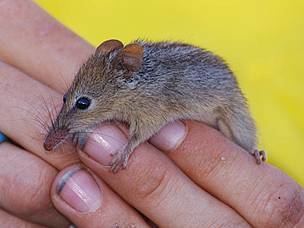Scientific name Tarsipes rostratus Rank Species | Phylum Chordata Higher classification Tarsipes | |
 | ||
Genus TarsipesGervais & Verreaux, 1842 Similar Marsupial, Mammal, Pygmy possum, Acrobatidae, Pseudocheiridae | ||
Honey possums on banksia
The honey possum (Tarsipes rostratus), also known by the native names tait and noolbenger, is a tiny Australian marsupial. It is the only species in the genus Tarsipes and in the family Tarsipedidae.
Contents
- Honey possums on banksia
- Cute cuter honey possum volunteering for parks and wildlife wa
- Description
- Distribution
- Behaviour
- Breeding
- References

Many authorities believe it is sufficiently distinct to be more properly raised to a separate superfamily within the Diprotodontia, or perhaps even further. It is thought to be the sole survivor of an otherwise long-extinct marsupial group.

It is an important pollinator for such plants as Banksia attenuata, Banksia coccinea or Adenanthos cuneatus.
Cute cuter honey possum volunteering for parks and wildlife wa
Description

Male honey possums weigh just 7 to 11 g (0.25 to 0.39 oz), and females weigh 8 to 16 g (0.28 to 0.56 oz); about half the weight of a mouse. Their body length ranges from 6.5 to 9 cm (2.6 to 3.5 in). Its teeth are fewer and smaller than is typical for marsupials, with the molars reduced to tiny cones, and a dental formula of

It is one of the very few entirely nectarivorous mammals; it has a long, pointed snout and a long, protrusible tongue with a brush tip that gathers pollen and nectar, like a honeyeater or a hummingbird. Floral diversity is particularly important for the honey possum, as it cannot survive without a year-round supply of nectar and, unlike nectarivorous birds, it cannot easily travel long distances in search of fresh supplies.
Radio-tracking has shown, however, that males particularly are quite mobile, moving distances of up to 0.5 km in a night and with use areas averaging 0.8 hectares. Both its front and back feet are adept at grasping, enabling it to climb trees with ease, as well as traverse the undergrowth at speed. The honey possum can also use its prehensile tail (which is longer than its head and body combined) to grip, much like another arm.
They have a typical lifespan between one and two years.
Distribution
Although restricted to a fairly small range in the southwest of Western Australia, it is locally common and does not seem to be threatened with extinction so long as its habitat of heath, shrubland, and woodland remains intact and diverse.
Behaviour
The honey possum is mainly nocturnal, but will come out to feed during daylight in cooler weather. Generally, though, it spends the days asleep in a shelter of convenience: a rock cranny, a tree cavity, the hollow inside of a grass tree, or an abandoned bird nest. When food is scarce, or in cold weather, it becomes torpid to conserve energy.
Breeding
Breeding depends on the availability of nectar and can occur at any time of the year. Females are promiscuous, mating with a large number of males. Competition has led to the males having very large testicles relative to their body weight, at a relative mass of 4.2%. Their sperm is also the largest in the mammal world, measuring 0.36 mm. Gestation lasts for 28 days, with two to four young being produced. At birth, they are the smallest of any mammal, weighing 0.005 g. Nurturing and development within the pouch lasts for about 60 days, after which they emerge covered in fur and with open eyes, weighing some 2.5 g. As soon as they emerge, they are often left in a sheltered area (such as a hollow in a tree) while the mother searches for food for herself, but within days, they learn to grab hold of the mother's back and travel with her. However, their weight soon becomes too much, and they stop nursing at around 11 weeks, and start to make their own homes shortly thereafter. As is common in marsupials, a second litter is often born when the pouch is vacated by the first, fertilised embryos being stopped from developing.
Most of the time, honey possums stick to separate territories of about one hectare (2.5 acres), outside of the breeding season. They live in small groups of no more than 10, which results in them engaging in combat with one another only rarely. During the breeding season, females move into smaller areas with their young, which they will defend fiercely, especially from any males.
